In many parts of the world, ATVs must be fitted with a spark arrestor (spark arrester), either by law or by local regulations. But what is a spark arrestor, and what is its purpose? Does it have any disadvantages? Can you safely remove it? How do you remove it? How do you clean it when clogged? We take a quick look at all these questions in this article.
The purpose of having a spark arrestor on an ATV is to prevent wildfires by trapping any glowing particles from the engine itself or carbon deposits that break free before they exit the tailpipe. Besides the advantage of preventing a wildfire, spark arrestors come with some other advantages or disadvantages, depending on how you look at it.
Not all ATVs are fitted with a spark arrestor. To check if your bike is fitted with one, you have to take a look at the rear end of your exhaust muffler because this is where it will be located if you have one.
On many mufflers, it is written on the outside whether an arrestor is installed or not. On others, you have to see if there is one physically.
Use a flashlight if the arrestor is not located at the very end of the muffler. You are looking for a fine steel mesh screen covering the whole inside diameter of the exhaust. It could be shaped like a tube or just like a plane screen.
If the screen is shaped like a tube, it can be harder to notice. Use a screwdriver to gently “feel” if there is a screen there. It should look something like this:
Although not as common as screen-style spark arrestors, some mufflers are fitted with a set of discs that the exhaust needs to pass through. These are usually fitted at the very end of the muffler and should be easily observed.
Some early ATVs were fitted with a centrifugal style spark arrestor, but this is not common today. These could not be removed but sometimes had inserts for back pressure tuning.
If your ATV does not have a spark arrestor, there is a chance that small particles from the engine itself will exit through the exhaust like a glowing red spark.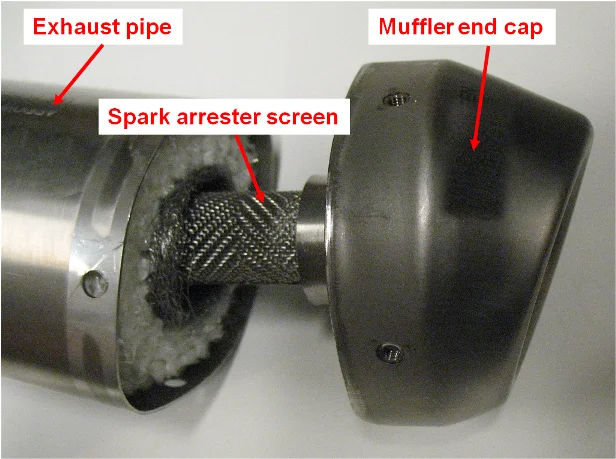 With today’s modern production technologies, the production of particles from the engine itself is no longer a common problem.
With today’s modern production technologies, the production of particles from the engine itself is no longer a common problem.
However, over time, carbon deposits can build up on the inside of your engine. Eventually, these deposits may break free, turning into a glowing red spark on its way out of the exhaust.
You may have seen this if you have ever been riding behind a bike without a spark arrestor installed at night time.
And yes, these sparks may cause a wildfire under the right circumstances.
The laws governing spark arrester use depends on where you are riding. In the US, there is a good chance you are required to have a certified and undamaged spark arrestor installed whenever you are riding on federally, state, or locally managed land.
It is always a good idea to check your area’s requirements before you head out to the trails.
But one thing is certain: Using a spark arrestor is always a good idea no matter where in the world you are riding where a spark could impose a potential fire hazard.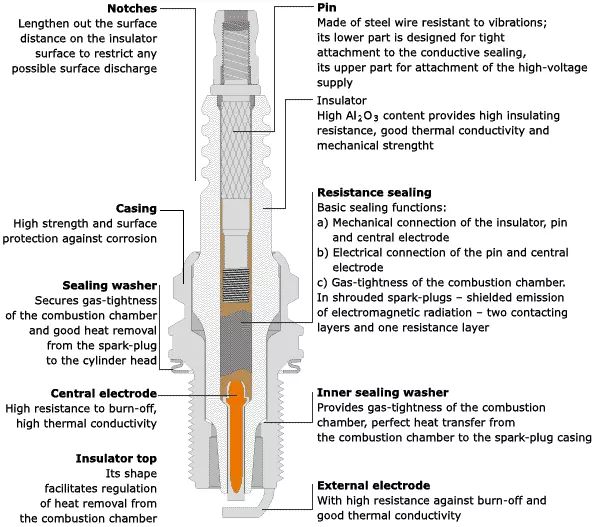
A spark arrestor is designed to trap any glowing sparks before they exit your tailpipe by acting as a filter.
On a screen-style spark arrestor, the mesh creates many tiny holes which the exhaust needs to flow through. Any particles larger than the holes in the mesh will be stopped. Screen arrestors come in different ratings depending on how fine a mesh is used.
A disc-style arrestor has the same effect. Many small discs are placed together with a small spacing to stop any particles from passing through.
Many are looking into removing their spark arrestor because of the potential power gains.
While the arrestor to a small degree will restrict the airflow that goes through the exhaust system, removing it is not equivalent to more horsepower.
The effect of removing it will depend entirely on how your quad is built and tuned.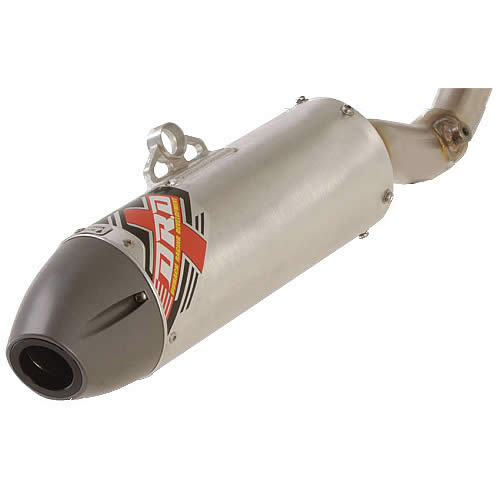 Variables like jetting, intake, elevation, cams, exhaust system design, etc., will impact the results.
Variables like jetting, intake, elevation, cams, exhaust system design, etc., will impact the results.
Removing it may or may not result in improved performance. You won’t know for sure until you have given it a try.
On some ATVs, you may even experience a small drop in power when you remove the spark arrestor. The reduced back pressure you get by removing it will on some systems result in decreased performance.
If you are lucky, and your systems react favorably to removing the arrestor, you are looking at potential top-end power gain in the range of 1 horse-power. Ironically, the reduced backpressure may at the same time give you just as much of a drop in low range power and torque.
If better performance is your end goal, I recommend keeping the spark arrestor installed until you can afford to get a quality aftermarket exhaust system (also with a spark arrestor) and a re-mapping of the engine. This could give you a significantly more noticeable increase in power than only removing the spark arrestor in an OEM system.
Installing a spark arrestor will result in a decrease in your system’s sound level, generally by a couple of dB.
Some riders love a louder and deeper sounding system and want to remove the arrestor to achieve this.
Others prefer their quads, and co-riders quads, to be more silent and discrete.
While I’m not trying to be the moral police here, it’s worth mentioning that noise complaints are the most common reason why people have an issue with offroad or trail riding. And with complaints comes restrictions on the use of tracks and trails. That’s just how it is.
So be aware, if you ride where noise can be an issue, you may risk ruining the fun for yourself and other riders.
Related: This is how you quiet ATV exhaust noise.
Some people think having spark arrestors on their quads is downright ugly and want to remove it for this reason only.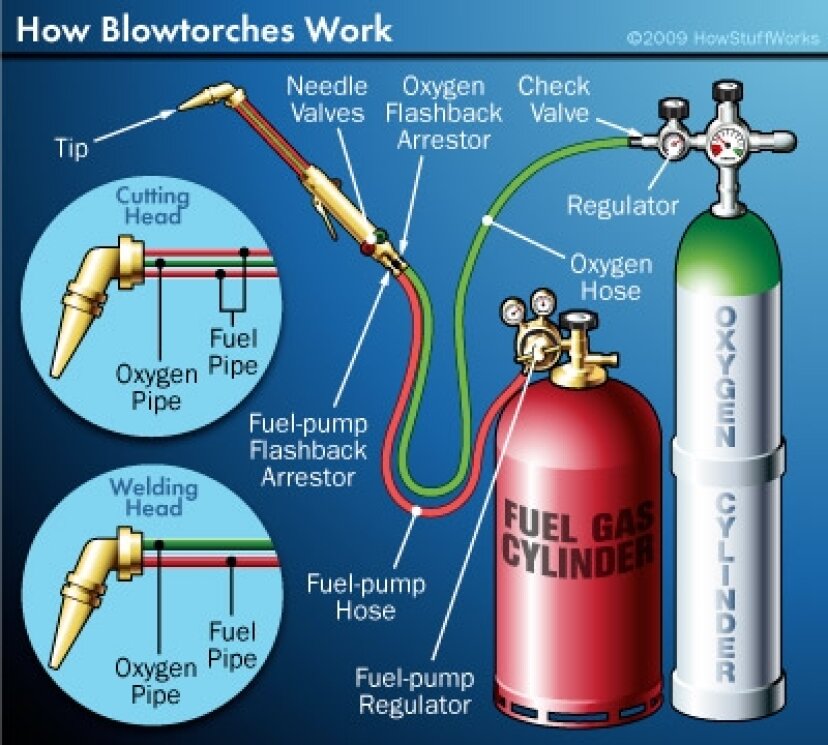
While I can agree design was probably not the top priority when many spark arrestors were designed, I will leave it up to you to decide if this is big enough of an issue for you to remove it.
Most spark arrestors can be removed from the muffler, some way or another. The procedure you need to follow to achieve this differs from model to model.
Usually, all you need to do is to remove the bolts or drill out the blind rivets holding the arrestor in place, and it should just pop right out.
Some systems may require some more work, and you risk ruining the arrestor in the removal process.
When removing the spark arrestor, you need to remember that your engine may be running a bit leaner than it did before due to the change in air/fuel ratio.
The air/fuel ratio is determined by your bike’s jetting setup, which can be altered to your specific need. So you need to make sure you are still within the recommended tolerances after removing the arrestor. Consult a mechanic if you are not sure how to do this.
Consult a mechanic if you are not sure how to do this.
You can safely remove the spark arrestor or even install an aftermarket exhaust system on many ATVs without having to make alterations to your jetting because they are normally set up to run a bit rich from the factory, but this is no general rule!
If you are unlucky, having your bike running too lean can, over time, result in damage to your engine. To be on the safe side, you should have your air/fuel ratio controlled by a professional whenever you make alterations to your exhaust system.
After riding, trapped carbon particles will build up in your spark arrestor, so it will need cleaning for your bike to be performing as it should.
A clogged up arrestor may result in a significant decrease in power because of exhaust flow blocking. This applies to both disks and screen style arrestors.
The user manual usually states that the arrestor should be routinely cleaned after running a certain amount of miles.
Usually, the arrestor is relatively easily removed for manual cleaning. Alternatively, the muffler may be equipped with a cleanout plug to access and clean the screen fast and easy.
For a disc-style arrestor, you need to disassemble and clean each disc individually.
One way to clean the parts is by using some fuel and a copper wire brush to scrub off any debris. Rinse in fuel and wipe clean with a rag. Let all the parts air dry before you re-install the assembly into the muffler.
However, the above method will work just fine, but it can be a bit time-consuming.
For screen-style spark arrestors, the easiest way to clean it is by using a blow torch to burn the carbon away.
This can be done after you have removed the screen from the muffler, or if it is easily accessible from the rear of the muffler, you can even burn away the carbon with the screen still installed in the muffler.
If you use this method, always make sure you use safety glasses and don’t put the torch against anything that can catch on fire, like your bike’s plastic fenders!
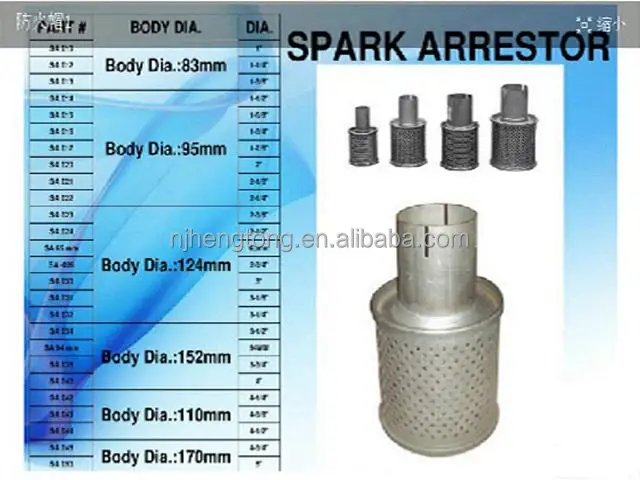 com
comSpark arrestors on some bikes can look pretty cool, but more importantly, they serve a very useful function.
All internal combustion engines operated in the USA must have spark arrestors fitted, including four-stroke engines.
In this post, you’ll learn what a spark arrestor does, where you must use it, and why some don’t like using them.
Page Contents
Spark arrestors are needed on all internal combustion equipment, two strokes or four strokes. It is fair to say that two-strokes are more commonly associated with sparks from the tailpipe.
That’s because two strokes rev at a much higher rpm and the gas oil mix tends to soot up and gather inside the muffler. As the tailpipe gets hotter, the soot catches fire, and if not for the spark arresting screen inside the exhaust tailpipe, the embers may be blown out of the tailpipe possibly causing a forest fire.
As the tailpipe gets hotter, the soot catches fire, and if not for the spark arresting screen inside the exhaust tailpipe, the embers may be blown out of the tailpipe possibly causing a forest fire.
The USDA spark arrester guide specifies that all internal combustion machinery must comply with forest services spec 5100-1d – they must have a working spark arrestor. While USDA states you need a spark arrester to ride on public trails, it is permissible to operate an internal combustion engine without a spark arrester on private lands.
Most kit will have one fitted from new but do check before you pull the pin. A good shop won’t have a problem fitting a spark arrestor. Modified used equipment likewise may not have them installed.
Most quality makers will have the spark arrestor part number and flow rating marked for all to see. Take a look at the very tip of the exhaust, look for model number or patient or flow rate, something like 28 cfm.
But if you don’t see a stamp, you can just check for an arrester yourself, the spark screen is easy to spot. Use your phone light to look into the tailpipe, if you see a mesh screen, you have an arrester fitted.
Yes, you can fit a spark arrestor easily. The aftermarket suppliers will have one to suit your make and model. Most require a drill and screws or some pop rivets to secure them right onto the existing tailpipe.
Yes, they do. Anything that restricts either the intake of air or the exhausting of gases will affect performance. But truthfully, it’s very slight, and most won’t even notice it. What you will notice is a distinct lack of performance if you don’t maintain the spark arrestor. A two-stroke will need more attention than a four-stroke engine.
All engine manufacturers will have their own specified maintenance schedule for cleaning however every six months or about 150 hours of riding is normal for four-stroke engines.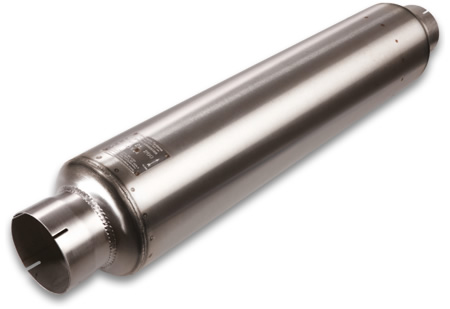 Two-stroke spark arresters will require more regular checking and cleaning.
Two-stroke spark arresters will require more regular checking and cleaning.
Spark arresters as you know, block or catch embers but they also trap carbon deposits in the very fine screen mesh which if not removed chokes the engine preventing spent gases from leaving the motor.
If spent gases can’t leave the muffler quickly it follows, the new engine cycle can’t begin, which results in poor engine performance. A fast efficient bike needs a clear airway and a clear exhaust path.
Two-strokes suffer the most, the oily gas mix of a two-stroke causes the arrestors to clog up more quickly. The arrestors block up with soot and begins to choke the engine progressively.
Symptoms of a blocked arrester vary by how badly blocked it is, typically you’ll notice:
If it’s been six months since you last cleaned it, and or you’ve covered about 150 hours riding then you can be sure it needs cleaning.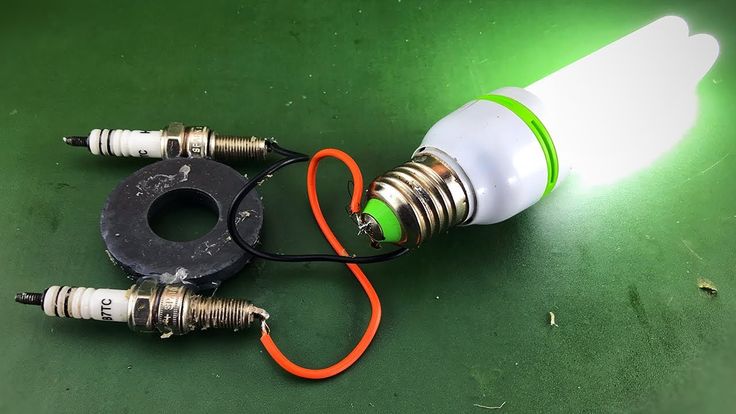
The screens are reusable but replace them if they’re choked or damaged or the screen is worn out. Old screens simply burn out in the center where they get hottest and see the most action.
This is a really simple job that brings huge benefits to your engine. Removing and cleaning a clogged arrester is a five-minute task. You’ll need a Philips screwdriver (usually) and a wire brush.
The process is as follows:
Replace a broken arrester, otherwise, it isn’t an arrester.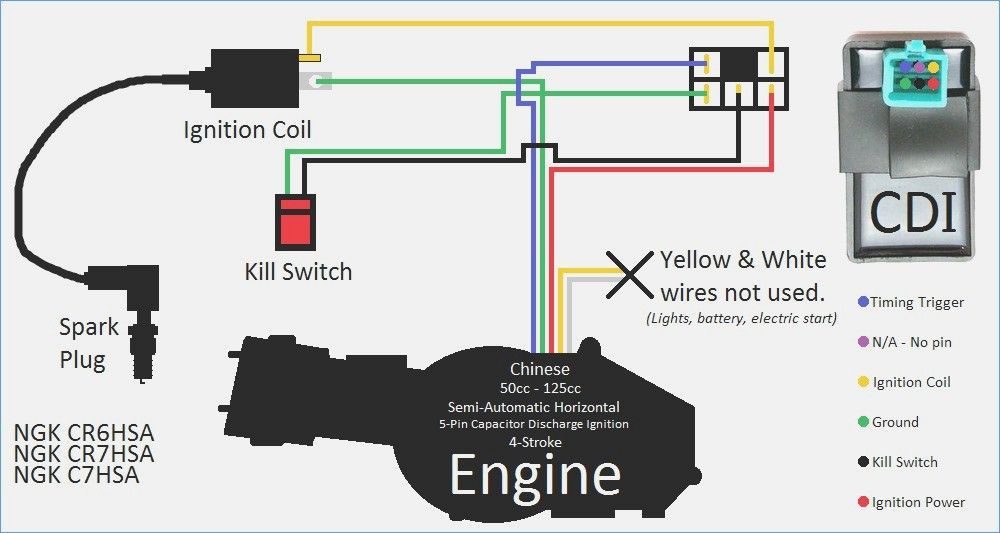
Job done!
You’ll find the tools I recommend here on the ATV tools page and you’ll find common spare parts here on the ATV parts page and on the Dirt bike parts page.
You may find the following posts helpful:
How often should I service my ATV?
Do ATVs have titles?
How often should I start my ATV?
How to start ATV in cold weather?
Should you dirt bike alone?
Think about how often you service your ATV? But this is an important component of the "health" of the all-terrain vehicle, on which the operation of all transport systems depends. And even if you decide to buy a new ATV, be prepared for the fact that sometimes you will have to face problems. For example, many riders complain that the ATV exhaust pipe gets hot. But this is a “bell” that some systems of the device do not work correctly. So let's figure out what to do if the muffler of the ATV is hot.
In fact, there are not so many reasons for the strong heating of the exhaust system.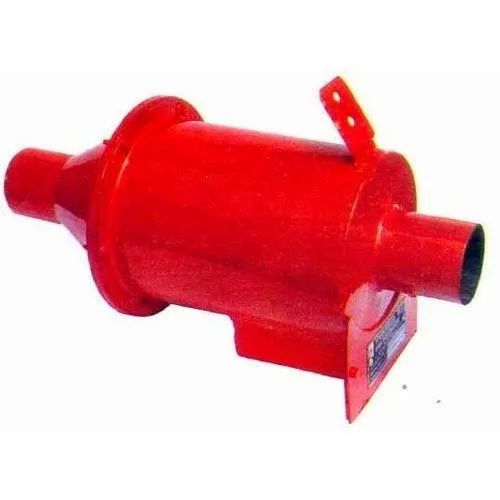 Most often, this situation occurs due to:
Most often, this situation occurs due to:
There are not so many reasons why the exhaust pipe gets hot on an ATV. And almost all of these problems can be eliminated even by a novice rider.
Even novice drivers know that the fuel mixture is prepared from gasoline and air. But at the same time, the proportions of the components play an important role. For example, if there is more air than gasoline, then the mixture will turn out to be too poor. And here the problems begin. A lean composition leads to a number of problems:
A lean mixture is also one of the reasons why the muffler gets hot on an ATV. The fact is that the remaining fuel gets into the pipe, which explodes in it. This leads not only to an increase in the temperature of the exhaust system, but also to serious damage.
The fact is that the remaining fuel gets into the pipe, which explodes in it. This leads not only to an increase in the temperature of the exhaust system, but also to serious damage.
If the ATV exhaust pipe gets very hot, first make sure the fuel mix is properly prepared. You can diagnose the problem by several key symptoms:
A simple carburetor adjustment will solve the problem. You can learn more about the procedure for cleaning and tuning the fuel system in our article.
Another reason why the muffler on an ATV gets hot is a melted spark arrester. This is a special mesh that is designed to dampen vibrations and noise. However, sometimes this component can melt or simply clog.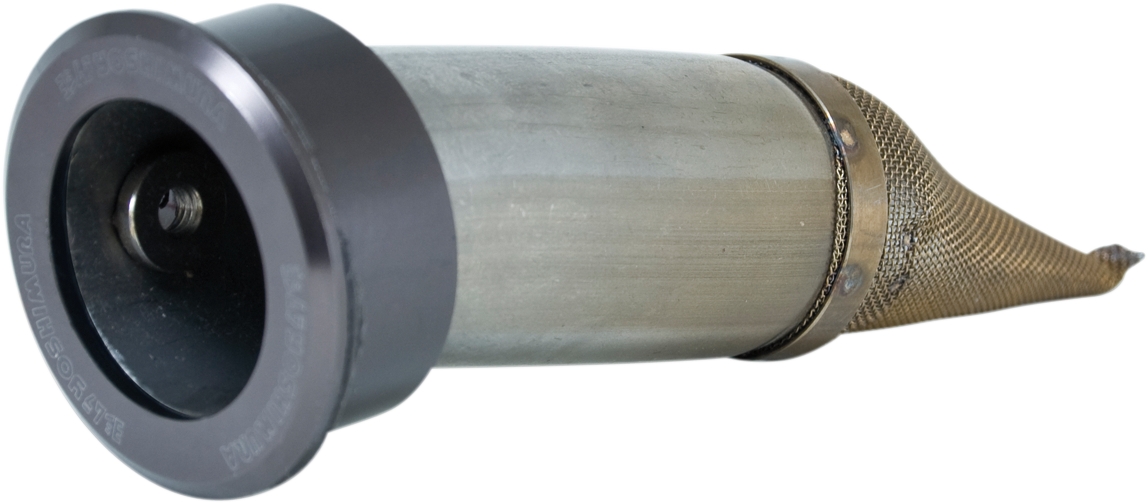 Because of this, the exhaust gases will not be able to exit the pipe, which leads to an increase in the temperature of the pipe.
Because of this, the exhaust gases will not be able to exit the pipe, which leads to an increase in the temperature of the pipe.
To check the spark arrester, unscrew the 3 bolts at the end of the exhaust pipe and carefully pull out the "innards" of the system. If the mesh is just clogged, it can be blown out. But the melted component should be replaced or completely abandoned.
Spark arrester problems are usually caused by an incorrectly tuned carburetor, rich or lean composition. If all quadric systems work correctly, the grid is cleaned every 10-12 thousand km.
Late ignition problems usually occur on quads with a carburetor. The essence of the problem is that the fuel mixture ignites too late and burns out already in the cylinders of the power unit. This leads to a drop in power, increased gas mileage and excessive carbon deposits. In addition, the burning out of the composition during the power stroke can cause the engine to overheat and excessive heating of the exhaust system.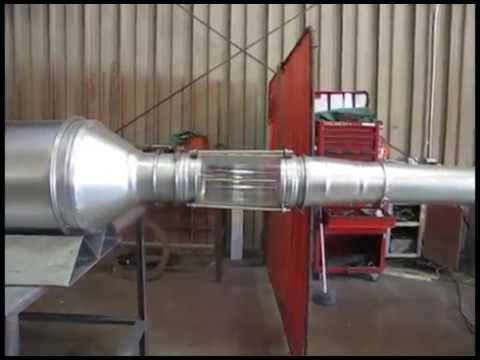
09/14/2021 2041
Articles
08 Feb
After a long wait for rides, the last thing you want is to face a breakdown in the middle of the forest, and then spend part of the season for repairs. Therefore, it is very important to properly service the ATV after the winter - change the oil, lubricate everything you need, make sure there are no backlashes and smudges, check the tightness of the bolts and nuts. We will talk about everything in more detail in the article.
This is important, because over time the oil loses its properties - because of this, heat is worse removed and friction between parts increases. All this leads to accelerated wear.
Please note that the ATV engine can only be filled with special oil for motorcycles - this is due to the clutch in an oil bath.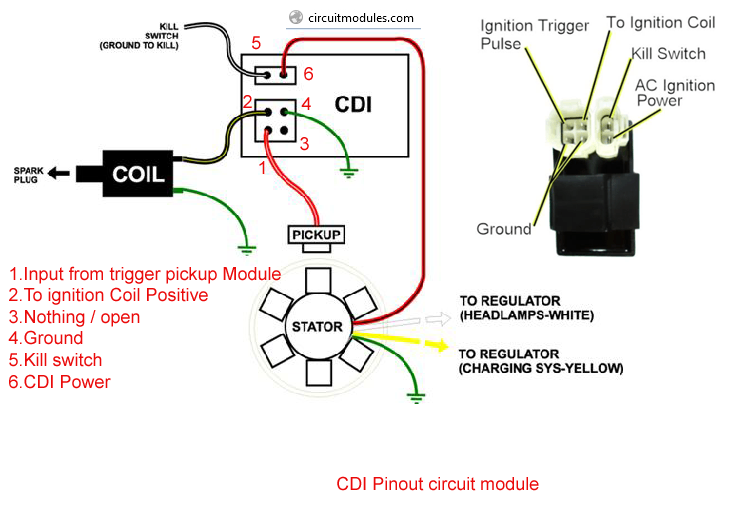 And it is advisable to use what the manufacturer recommends, as it guarantees stable operation under increased loads. For example, for CFMOTO there is a special line of CFMOTO G-Motion oils.
And it is advisable to use what the manufacturer recommends, as it guarantees stable operation under increased loads. For example, for CFMOTO there is a special line of CFMOTO G-Motion oils.
Two things are checked:
The air filter prevents dust and small particles of dirt from entering the engine, so it is important to keep it in good condition.
To clean the foam filter, wash it in warm water with Fairy or in a special agent, wring it out a little (do not twist it) and dry it. After that, impregnation with oil for filters is necessary.
When driving, the radiator becomes clogged with seeds, grass, lint and dirt. If you do not clean it, the next ride can turn into a test - a long road to the house with constant stops to cool the engine.
If you do not clean it, the next ride can turn into a test - a long road to the house with constant stops to cool the engine.
It is better to clean the radiator with a compressor by removing the protective grille. It is undesirable to use a pressure washer due to the risk of damaging the honeycombs.
It is best to move the radiator to the front luggage area - it is more convenient to service, you can safely overcome puddles and other water obstacles without fear of subsequent overheating of the engine due to stuck dirt.
Important: if you plan to dive deep into the water, it is obligatory to install snorkels, seal the wiring and remove the breathers - without this, it is highly likely that the swim will end tragically for the equipment.
During long storage, gasoline deteriorates - fractions evaporate, the octane number becomes lower, oxidation and precipitation occur. If you drive on such fuel, the piston group and the fuel system may suffer, so it is better to fill in fresh.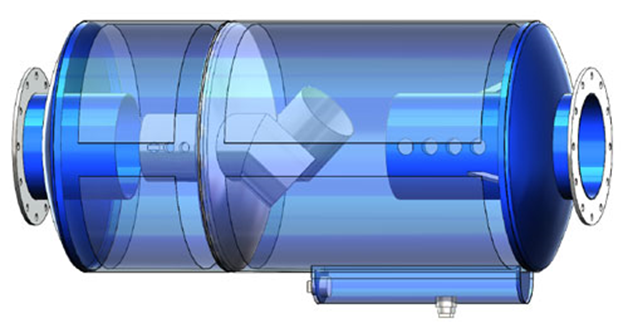
There should be no play - try to shake all the rods and levers by hand. You also need to make sure that there are no oil smudges on the shock absorbers.
It is necessary to check the cardan shafts for play, make sure that there are no breaks or damage on the anthers of the CV joints.
It is also important to inspect the variator belt: if there are cracks or broken teeth, a new one must be installed. The variator itself can be blown out with compressed air. Lubrication of its individual parts is required only if it is indicated in the instruction manual (it all depends on the ATV model).
Timely renewal of grease will help extend the life of the components. Depending on the model of the ATV, the number and location of injection points may be different. Usually they are on the suspension arms, crosses and spline joints of cardans, steering knuckles.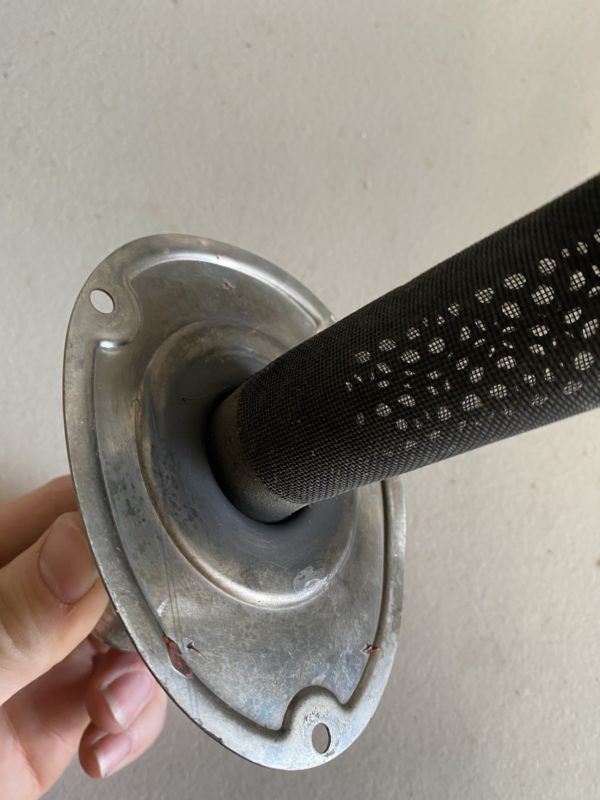
To do this, take the wheel on the sides and shake it in different directions, jacking up the ATV. If there is play, the wheel bearings are most likely worn out, less often the bushings.
Check:
Recommended ATV tire pressure can be found in the owner's manual and also on the machine itself, usually near the left rear fender.
It is not necessary to be guided by the value indicated on the tires themselves - this is the maximum pressure that the tire can withstand.
Apply a protective spray or electrical lubricant to the contacts and connectors to prevent moisture ingress and malfunction of the ATV.
Even before the season, you must make sure that the high and low beams, side lights, emergency alarm, power steering, turn signals, horn, winch and heating are functioning normally.
Normally, the battery charge is from 12.5 V. If it is less, it should be charged. Plaque on the terminals, cable lugs and the battery case itself can be removed with a sponge moistened with a solution of baking soda in water.
A new quad needs a break-in so that the piston rings rub against the cylinder. This will ensure normal heat transfer and prevent serious damage - for example, burning or jamming of the piston.
Run-in is carried out in the first 500 km of run.